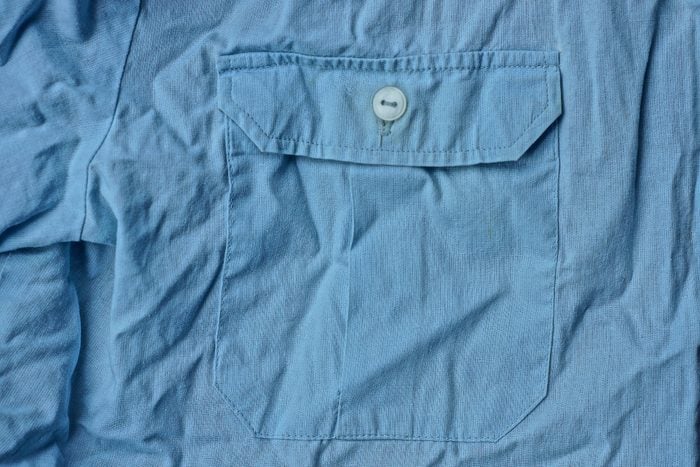
Removing wrinkles without an iron
Once upon a time, I ironed dress clothes and even table linens for formal dinners, but who has the time for that these days? I’m a working mom of five! Plus, my husband and I both work from home. To be completely honest, my ironing board broke two years ago, and I haven’t replaced it. That said, I still occasionally need to know how to get wrinkles out of clothes (hello, family photo day!), and when I do, I need a quick, iron-free wrinkle solution.
If you’re like me or maybe don’t even own an iron, the first thing you need to know is why wrinkles form in the first place after you do laundry. (Aside from leaving your laundry in an unfolded heap, that is.) “Wrinkles form in fabrics when they encounter moisture and heat,” says fabric-care expert Mary Marlowe Leverette. “Fabric polymers are held together by hydrogen bonds that break and shift into new positions when they are subjected to heat and moisture. When the fabric drys and cools, it takes on the shape created while heated—like the creases in pants that form after you’ve been sitting all day.”
As I’ve learned in my decade-plus as a cleaning writer, removing wrinkles from clothing involves reversing the process that causes them in the first place: loosening the fibers of the fabric, often through heat and water, so they form into new, smooth shapes. I spoke with three experts whose jobs depend on getting wrinkles out of clothing—LaundryTok favorite Melissa Dilkes Pateras, author of A Dirty Guide to a Clean Home, and stylists Yenia Hernández Fonseca and Saffron King—to find out how to get wrinkles out of clothing without an iron.
Get Reader’s Digest’s Read Up newsletter for more cleaning, tech, travel, humor and fun facts all week long.
About the experts
Reviewed for accuracy by: Mary Marlowe Leverette. |
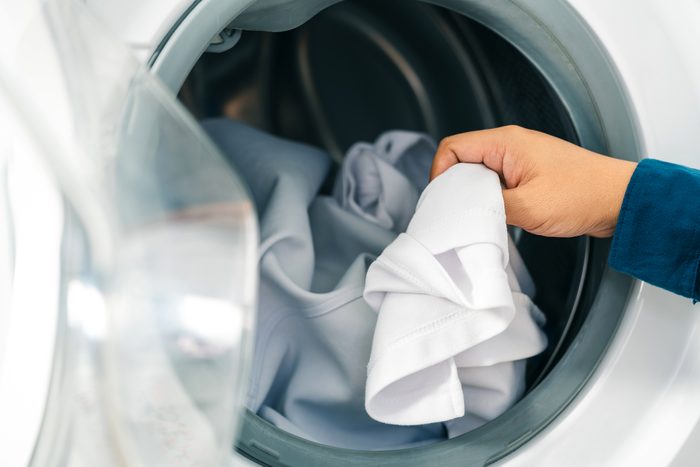
Toss wrinkled items in the dryer
Raise your hand if you’ve used this iron-free method on wrinkles. It’s my go-to, and my kids have even learned how to get wrinkles out of clothes with this simple trick. But you can’t just use an ordinary hot setting—you need steam, which relaxes a garment’s fibers and loosens the wrinkles, according to Fonseca. While some dryers have a steam cycle that makes wrinkle removal really straightforward, you can craft a similar environment by adding a little moisture yourself. Here’s how.
- Place only the clothes you need to unwrinkle in the dryer.
- Next, introduce moisture, using one of several options: wet a cloth (soaked but not dripping) and put it in the machine; toss in a few ice cubes (Fonseca and Pateras’s preferred method, and what I do too); or mist your garment with water.
- Run the dryer for about 15 minutes. You can choose the Quick Dry setting or set the timer. Opt for the hottest setting that your fabric will allow (check your garments’ care labels), as this will generate the most steam.
- Remove the garment promptly. Allowing it to sit in the dryer will reintroduce wrinkles and undo all your hard work.
- Immediately hang the garment, and allow it to cool. If you put it on right away, wrinkles will immediately form anywhere your body bends.
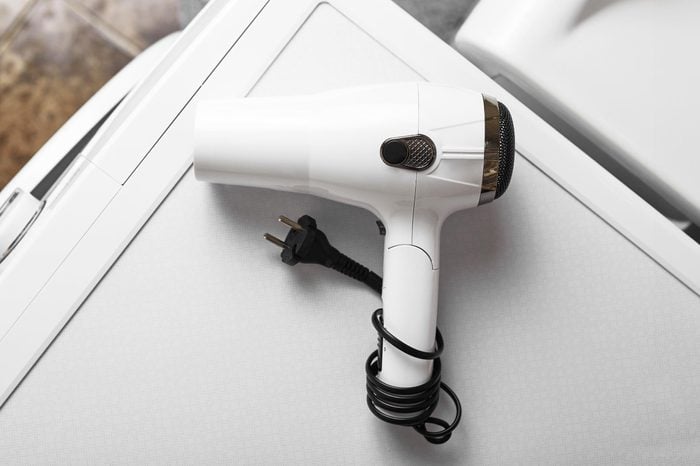
Use a hair-dryer
A hair-dryer can work in a pinch. Just keep in mind that this wrinkle-removal method “requires a lot of pulling on the fabric, which can stretch it,” according to Pateras, so be careful not to tug too hard as you’re smoothing out your item. In a pinch, you could use this method to address a small wrinkled area while wearing the garment, but generally speaking, it’s safer and easier to do this when the item is not on a person.
- Hang the garment on a hanger. Fonseca recommends using a contoured hanger, which not only prevents stretched-out shoulders but also holds the front and back of the garment farther away from each other, allowing for more airflow.
- Mist the garment with water from a few inches away so the garment is slightly damp. Just like with the dryer method, heat alone won’t do as much as heat plus water. You need the steam created by the mist plus the heat of the dryer.
- Set the dryer to an appropriate heat setting. This will depend on the type of fabric your garment is made from. King suggests a low or cool setting to start. “Too much heat can damage delicate fabrics, so go slow and steady,” she says. However, keep in mind that the hotter the air, the more the fabric’s fibers will relax.
- Gently smooth the garment with your hands while blowing the air on it. Slight tugging can also encourage the fibers to relax. Just be sure not to stretch your garment.
Pro tip: For delicate garments, King suggests using a diffuser attachment. “Using a diffuser while blow-drying your clothes to release wrinkles ensures gentle airflow,” she explains.
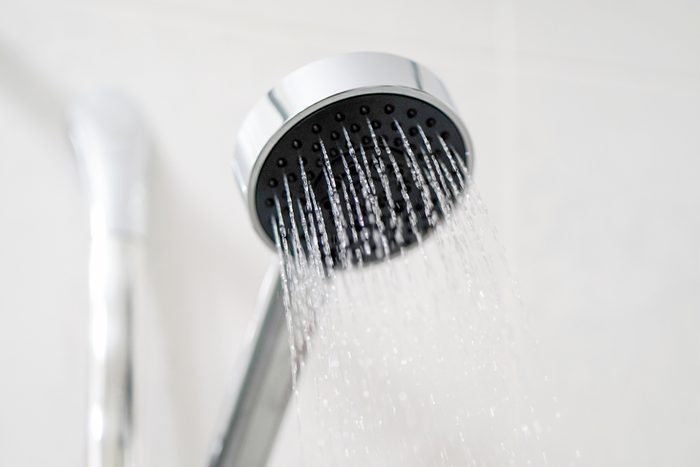
Hang in a steamy bathroom
Steam from the shower is a great method to get wrinkles out of clothes while traveling, like if you’re in a hotel, says Pateras. However, she cautions that this probably isn’t something you should do at home regularly because it’s important to vent your bathroom to prevent mold. But no matter where you try it, I’ve found that it works best on garments made of light fabrics that release wrinkles easily, such as synthetic blends. Don’t expect this method to do much for a badly creased cotton dress shirt.
- Choose the smallest bathroom you can in order to maximize the steam in the space.
- Hang your garment on a contoured hanger. Fonseca says this will help you avoid stretched-out shoulders.
- Hang the hanger as close to the steam source as possible without getting the garment wet. One good spot could be on the shower-curtain rod.
- Use hot water to steam up the room. Doing this while you’re showering, of course, is an efficient choice. Just make sure your garment is far enough away from where you’re showering (like at the far end of the rod) so it doesn’t get wet or soapy.
- Keep the door and any windows closed so that the steam remains in the room.
- Allow the garment to remain in the room as long as possible. A silk dress may be ready to wear after 15 minutes in a steamy room, while a cotton sweater may need a half hour or more. And a men’s button-down may show some improvement after steaming, but it will still need some more targeted treatment to look crisp.
- Keep the item on a hanger, allowing it to cool fully before putting it on.
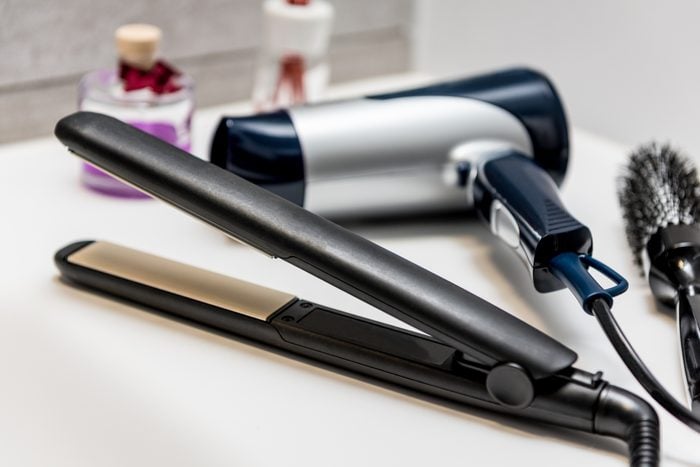
Smooth with a hair straightener
A hair straightener can be a convenient, accessible way to use heat and pressure to remove wrinkles, though Pateras points out that this method can be time-consuming because of the small size of the straightener. For that reason, Fonseca says it works best on collars, cuffs and small, hard-to-reach areas. Here’s how she suggests using a hair straightener to remove wrinkles—without scorching your garment.
- Inspect your straightener to make sure it’s free of any hair-product residue that could transfer to your garment.
- Turn on your straightener. Choose a heat setting that works with the instructions on the care label for your garment, since high heat can damage delicate fabrics.
- Pass the straightener over wrinkles on your garment, using light pressure to mimic the pressure of a clothes iron. Since your heat setting should be set at a safe temperature for the fabric, it’s fine to pass the straightener slowly over your garment.
- Repeat passes with the hair straightener until the wrinkles are gone.
- Hang your garment, and allow it to cool.
Pro tip: “Unless your hair straightener has a low heat setting, I’d stay away from any delicate fabrics, such as satin,” Fonseca says. Interestingly, hair-straightener temperatures often mirror the high and low temperatures of many clothes irons (about 230 degrees to about 450 degrees).
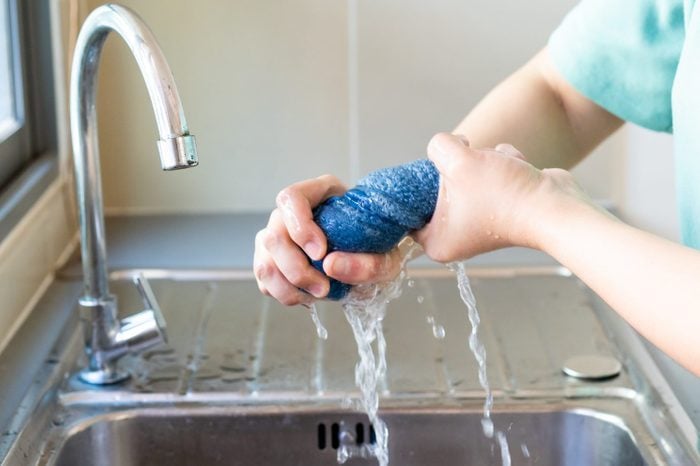
Cover with a damp towel
The damp-towel method is convenient because you don’t need any additional tools—you literally only need a damp towel. According to Fonseca, “this works wonders in the summer for cotton, linen and other natural fabrics.”
- Place a towel on a large, flat surface. Lay the garment on top of it. (Make sure the towel is big enough to fit the entire item.)
- Wet another towel, and squeeze out excess water until it is just damp. You don’t want to get the garment or the surface too wet because it will take too long to dry.
- With your hands at a slight angle away from each other, press gently but firmly. This hand positioning will stretch the fabric slightly beneath the towel. Once you’ve pressed over the entire garment, lift the top towel to see your results. Repeat if you need to get out more wrinkles.
- Hang to dry. Fonseca recommends hanging the garment to dry outside because airflow can help loosen the fibers and release the wrinkles even more. If it’s too cold outside, or if it’s more convenient, you could also finish drying your garment with a hair-dryer, time permitting. The heat of a hair-dryer is particularly effective when used with the damp-towel method because it introduces steam to the fibers.
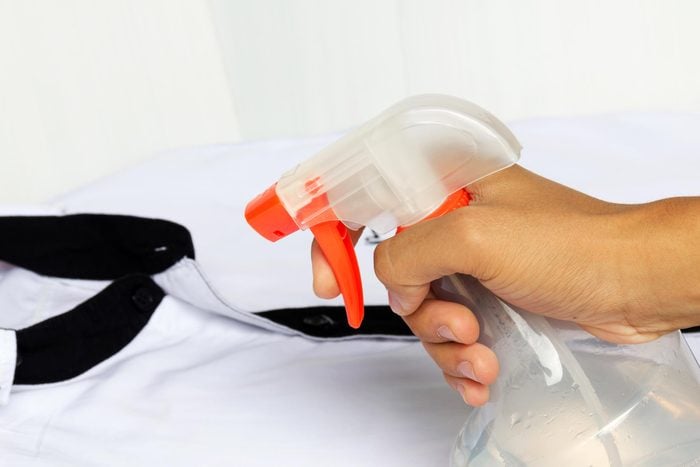
Buy a wrinkle-release spray
Wrinkle-release sprays encourage wrinkles to—you guessed it—release. They often contain fabric softeners that relax the fibers and allow them to dry in a new, smooth shape. Ever since I discovered these handy store-bought sprays, dressing up the kids for recitals or other special events has become a lot less stressful. They’re also Pateras’s favorite way to get wrinkles out of clothes, but she does point out that they “won’t give you a crease in your pants or a crisp collar” like an iron would.
- Hang your garment on a contoured hanger to avoid stretching the shoulders and to allow maximum airflow between the front and back of the item. You can also lay the garment on a flat surface covered by a towel.
- Spritz the garment with the product. Spray lightly on the fabric, Fonseca says, to avoid any liquid spots that can be problematic for delicate fabrics. Also spray the garment evenly from a suitable distance—about 8 inches away and in a “sweeping motion,” according to the directions for Downy Wrinkle Releaser—so you don’t oversaturate any one area.
- Smooth the garment with your hands, and tug gently to encourage wrinkles to release. Repeat, as needed.
- If your garment isn’t already on a hanger, hang it up to dry.
Pro tip: Fonseca is a fan of combining wrinkle-releasing methods. After using the wrinkle-release spray, she suggests hanging your wrinkled garment in a steamy bathroom or blowing it with a hair-dryer set at medium heat for best results.
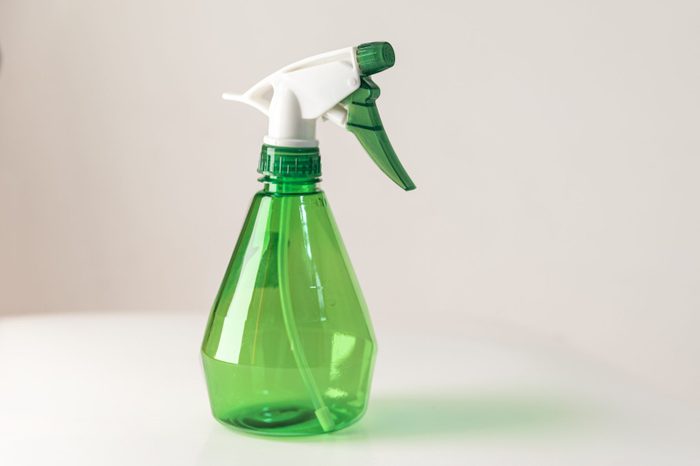
Make your own wrinkle-release spray
Want the convenience of a wrinkle-release spray but don’t have one on hand? You can make your own with water and either liquid fabric softener or hair conditioner. You could also use white vinegar, which is often used as a natural fabric softener. Here’s Fonseca’s go-to formula:
- In a spray bottle, mix equal parts water and white vinegar. Alternatively, you can mix 1 teaspoon of liquid fabric softener or hair conditioner per cup of water.
- Spritz the front and back of your garment. You can do this while it’s on a hanger or laying flat.
- Gently tug your garment to encourage the wrinkles to release, and/or smooth wrinkles by passing your hand with gentle pressure across the surface of your garment. Again, be sure to address both the front and back of your clothing.
- Hang your garment to dry (if it isn’t already hanging).
- To further encourage the release of wrinkles, hang it in a steamy bathroom or outside, or blow-dry it with a hair-dryer set to medium heat.
Pro tip: Pateras prefers using vodka instead of white vinegar in her homemade spray. She isn’t a fan of the smell that white vinegar leaves behind and points out that vodka can also aid in odor removal.
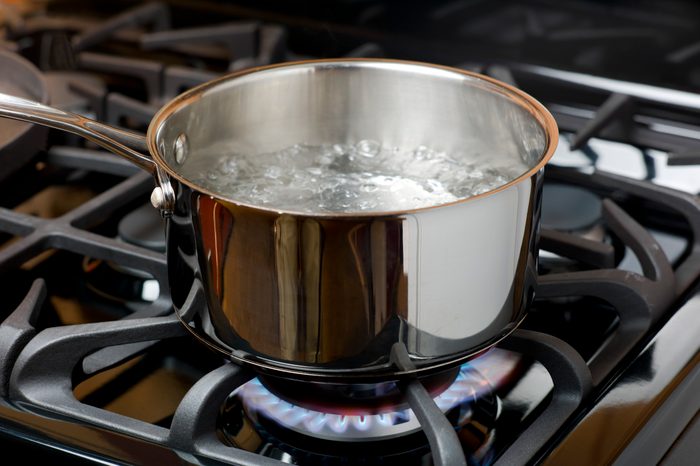
Turn the bottom of a pot into an “iron”
If you don’t have an iron, this method allows you to make your own iron out of something you do have on hand. It works by applying direct heat and pressure to the garment, much like an actual clothes iron, and according to Fonseca, it works best on heavy-weight fabrics.
Just keep in mind that delicate fibers can be damaged by high heat. Although the bottom of a pan of boiling water will not get hotter than the high temperature of an iron, it’s always important to heed the care labels of your garment—and, of course, be careful when handling a hot pot for your own safety.
- Choose a pot that doesn’t have burnt-on food or other dirt on the bottom. You don’t want to transfer any stains to your clothing.
- Turn your garment inside out to further reduce the risk of getting it dirty from the bottom of the pan (just like you would with a real iron).
- Boil some water in a pot to heat the bottom of the pan.
- Set out a towel on a hard, flat surface while the water is coming to a boil.
- Pour the water into the sink after it comes to a boil, and let the pot cool slightly.
- Gently press your garment with the bottom of the pan. Glide it across the fabric, or lift and press by sections. Applying the pot directly to the garment will yield the best results.
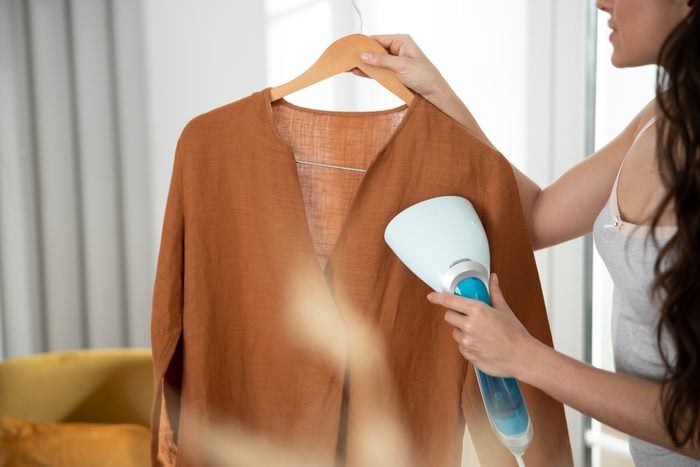
Use a handheld steamer
A favorite of stylists everywhere for getting wrinkles out of clothes, steamers are easy to use and get the job done. Yes, a steamer is another small device, but hey, it’s not an iron! Always check and follow the directions for your particular handheld steamer, and exercise caution when using it on delicate fabrics such as wool, silk, chiffon and velvet. Also, do not steam dry-clean-only fabrics, suede, waxed jackets or leather. With that in mind, here’s how to use a steamer properly:
- Fill your steamer with water. Fonseca recommends distilled, bottled or filtered water. “Tap water carries minerals that can clog the steamer over time,” she explains.
- Hang the garment, using a contoured hanger if you have one.
- Turn on your steamer. When it starts producing steam, it’s ready to use.
- Hold the garment taut, grab the front hem and softly pull it down to stretch the fabric.
- Then, insert the steamer inside the garment (not the outside) and press the mouthpiece against the fabric. Remember to keep your face away from the steam.
- Run the steamer up and down in sweeping motions, making sure not to leave the steamer in any one spot. According to Fonseca, this technique prevents water from spilling and potentially marking your clothes. Don’t forget to steam both the front and back of your garment.
- Allow your steamed garment to cool down and dry before wearing.
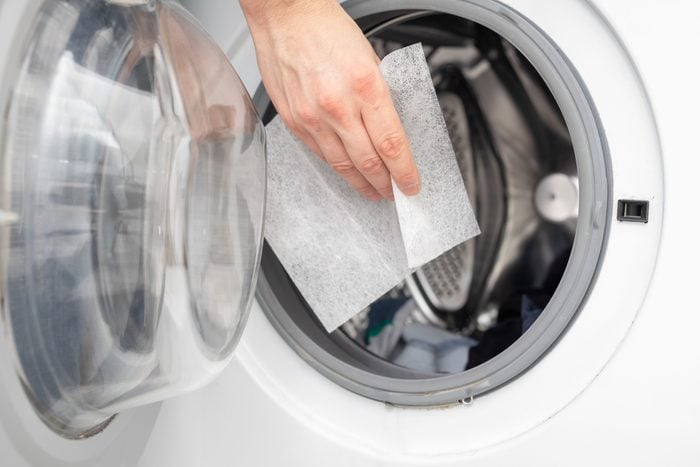
How to prevent wrinkles in the first place
As with so many household tasks (and life, in general!), an ounce of prevention is worth a pound of cure. Doing what you can to avoid wrinkled garments saves you time, energy and a whole lot of frustration, especially when you’re in a rush. Get in the habit of using these tried-and-true ways to prevent wrinkles, and they’ll become second nature.
- Use dryer sheets or wool balls. Dryer sheets reduce static cling and soften clothes, which, in turn, relaxes the fibers and prevents wrinkles. Wool dryer balls also decrease static, as well as increase airflow, since they keep clothes from clinging to one another in the dryer.
- Remove clothes from the dryer right away. Allowing clothes to sit in the dryer can cause wrinkles and set them in (as most of us know all too well). Instead, take them out of the dryer immediately. Use your dryer’s Wrinkle Guard setting if you aren’t able to remove clothes from the dryer right away; this feature periodically turns the dryer back on, and the heat and movement keep the clothes from cooling off and the wrinkles from setting in.
- Hang-dry your clothes. King suggests skipping the dryer altogether and air-drying instead. “Hang clothes strategically in a well-ventilated bathroom after a shower, or outdoors on a breezy day,” she says. “The steam and airflow work wonders, leaving you with breezy, relaxed vibes—and saving you energy too!”
- Leave space between your hanging clothes. Packing clothes too tightly into your closet can create wrinkles. “Clothes need space to breathe to prevent wrinkles, so avoid cramming your closet full,” says Fonseca.
- Roll clothes instead of folding them. Packing is one of the most common ways to get wrinkles in your clothes, but rolling clothes in your suitcase can prevent this. “Rolling clothes for travel minimizes creases and maximizes suitcase space,” King says. She also suggests placing tissue paper between delicate items such as silks for an extra layer of wrinkle prevention. You can also do this at home, though I personally fold my clothes but place them vertically in my drawers; this helps reduce wrinkling because there isn’t as much pressure on the clothes as there would be if they were stacked.
- Choose clothing that doesn’t need to be ironed. When it comes to preventing wrinkles, says King, “fabric choice is key.” For those who want to minimize their ironing (or avoid it altogether), she recommends investing in fabrics that naturally resist wrinkles, such as wool, polyester, Lyocell and knits.
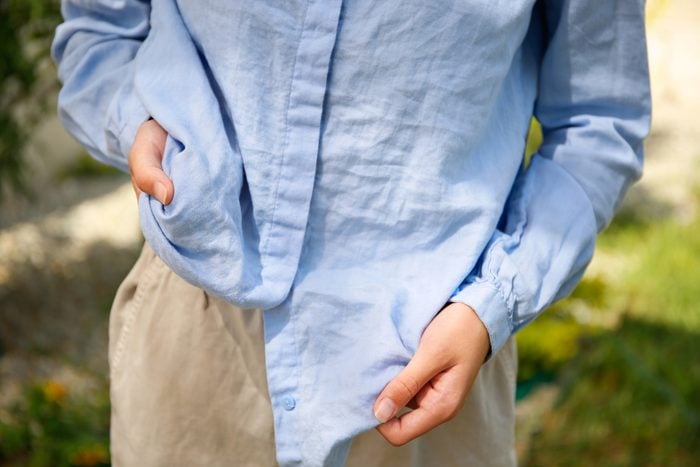
FAQs
Will a shirt unwrinkle as you wear it?
As much as we all wish it were the case, no, a shirt will not unwrinkle as you wear it. If you want clothes without wrinkles, you need to do the work to get rid of them or take some precautions to make sure your items don’t wrinkle. You can also opt for wrinkle-resistant garments, whether they’re made from fabric that doesn’t wrinkle (such as nylon, polyester and wool) or treated to resist wrinkles, such as some men’s dress shirts.
Can you remove wrinkles by putting a garment under a mattress?
I’ve seen this tip for how to get wrinkles out of clothes on a few different sites, though I’d never heard of it before working on this story. Fonseca hadn’t heard of it either. Her thoughts? “I guess the pressure and the weight of the mattress helps with flattening wrinkles, but this sounds too complicated compared to other ironing alternatives.” Even though I was skeptical because the method is missing the required heat component, I still wanted to try it out. So I carefully laid out my wrinkled shirt, rolled it gently and then placed it under a mattress for about 30 minutes. It did not work, and in fact, it made my shirt more wrinkled!
That said, I may have made a fatal error when testing this method, according to Leverette. Instead of rolling the garment, I should have laid it out perfectly flat and smoothed it into the correct shape before placing it under the mattress; this would have prevented new wrinkles from forming. Leaving the garment under the mattress overnight also would have produced better results. That said, the other wrinkle-releasing methods are easier and far more reliable, so I’ll probably stick with those.
Why trust us
At Reader’s Digest, we’re committed to producing high-quality content by writers with expertise and experience in their field in consultation with relevant, qualified experts. For this piece, Shifrah Combiths tapped her decade-long experience as a cleaning and organizing writer, and then Mary Marlowe Leverette, a fabric-care expert with more than 40 years of experience, gave it a rigorous review to ensure that all information is accurate and offers the best possible advice to readers. We verify all facts and data, back them with credible sourcing and revisit them over time to ensure they remain accurate and up to date. Read more about our team, our contributors and our editorial policies.
Sources:
- Melissa Dilkes Pateras, founder of TikTok channel @melissadilkespateras and author of A Dirty Guide to a Clean Home: Housekeeping Hacks You Can’t Live Without; email interview, Jan. 29, 2024
- Yenia Hernández Fonseca, personal stylist; email interview, Jan. 24, 2024
- Saffron King, head fashion stylist, buyer and author at Blue Bungalow; email interview, Jan. 24, 2024
